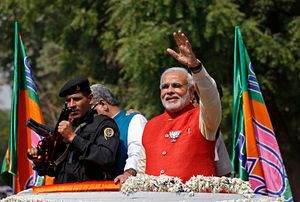India’s Prime Minister Narendra Modi will visit Nepal for a two day trip starting August 3. This will be the first bilateral visit of an Indian Prime Minister to Nepal in 17 years. Modi’s visit will follow a three day visit to Nepal last weekend by India’s External Affairs Minister, Sushma Swaraj. Minister Swaraj was in Nepal to co-chair the meeting of the Indo-Nepal Joint Commission, which was held after a gap of 23 years. These visits are in line with the Modi government’s policy to improve relations with India’s neighbors. Additionally, as The Diplomat previously noted, India’s ruling Bharatiya Janata Party (BJP) has long advocated better relations with Nepal, considering it to be a fellow Hindu-majority state.
Modi’s visit is partly motivated by a desire for India to lead the region’s smaller states, instead of antagonizing them, as it has sometimes done in the past. His first foreign visit as Prime Minister was to the other small Himalayan state of Bhutan, with which India has historically been close. Nepal, however, is more important because of its larger size and vital position straddling the Himalayas between China and India. If one glances at a map, one will notice that Nepal resembles a wedge sticking into India dangerously close to its heartland in the Gangetic Plains, home of some of India’s largest cities. Thus for India, it is exceedingly important to not cede influence in Nepal to any other country. Its location also cuts into the middle section of India’s northern border, preventing India from having a border there that encompasses the natural defense of the Himalaya Mountains.
Indeed, India has been alarmed over the past few years at the growing influence of China in Nepal, especially after the rise of the Maoists in Nepal. However, recently the power of the Maoists has declined vis-à-vis other Nepalese parties and there is a general consensus among Nepalese politicians of all parties for better relations with India. Geography, history, and culture all make it unlikely that Nepal will ever lean closer to China than it does to India. However, Nepal continues to play India and China off against each other, to the worry of many in India. Additionally, a recent Chinese plan to extend its railway system in Tibet to the Nepalese and Indian borders has concerned many in India.
Ultimately, however, both Modi and the Nepalese government are eager to improve relations. Nepal needs India to boost its economic growth and to shore up its fragile constitutional process, which has been going on for years. A lack of Indian engagement on these issues could have created disillusionment in Nepal towards India. Fortunately, Modi’s visit proves that India is engaged with and interested in Nepal. Nepal’s enthusiasm for Modi is indeed great, after the relative neglect of the previous Congress government in India towards the Himalayan state. This is evidenced by the plan of Nepal’s Prime Minister, Sushil Koirala, to personally receive Modi upon his arrival at the airport in Kathmandu.
Nepal and India are expected to take concrete steps to improve relations between the two countries, as Minister Swaraj’s visit has already demonstrated. During her trip, progress was made on cooperation in the realms of trade and infrastructure. The highlight of Modi’s visit is expected to be the signing of a major power deal between the two countries. The Power Trade Agreement (PTA) is supported by all major Nepalese parties, including the ruling Nepali Congress and the Maoists, who are quite often wary of India. The agreement will allow Nepal to export power to India. This will bring in much needed power to India and cash to Nepal. According to many sources, Nepal has the world’s second greatest potential hydropower reserves, with an estimated yield of 83,000 megawatts. Nonetheless, nearly half of its population cannot meet its energy needs as Nepal generates only 800 megawatts of energy per year. An agreement with India will open up the possibility of India helping Nepal develop a market for power that can supply all of Nepal as well as parts of India. However, due to the insistence of leftist parties in Nepal, wary of becoming dependent on India, any country can continue to invest in Nepal’s energy sector, and not exclusively India. Despite this, Nepal is expected to ask India to help develop numerous hydropower plans and is reported to be considering an idea to ask Modi to gift it a medium-sized hydropower project.
India and Nepal are both very important for each other. Although their relationship has sometimes gone off the rails, Modi’s forthcoming visit will probably do much to put the bilateral relationship between the two countries back on track, first by improving trust, and secondly by implementing concrete projects that would tie the two nations closer together.

































